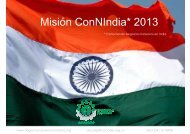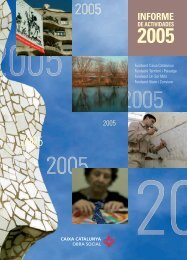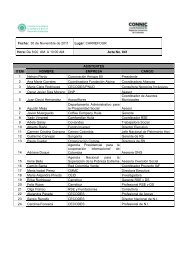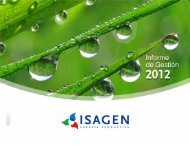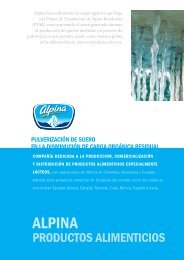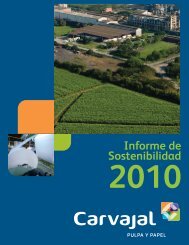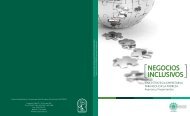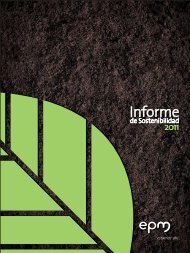Setting new standards - Friends Life
Setting new standards - Friends Life
Setting new standards - Friends Life
You also want an ePaper? Increase the reach of your titles
YUMPU automatically turns print PDFs into web optimized ePapers that Google loves.
INTERNATIONAL LIFE & PENSIONS ASSET MANAGEMENT GROUP FINANCIAL PERFORMANCE CONCLUSIONS AND OUTLOOK<br />
Group EEV underlying profit before tax has reduced by 3% to £509m (2005:<br />
£524m). Overall profit from our life & pensions businesses is unchanged but<br />
there has been an 18% decrease in profit at our Asset Management business,<br />
where we have seen a net outflow of funds and resulting lower revenues.<br />
Group EEV profit before tax has reduced by 34% to £398m (2005: £600m). This<br />
profit measure takes into account the impacts of investment return variances,<br />
economic assumption changes, non-recurring items and other costs. In net<br />
terms these were negative by £111m in 2006 but positive by £76m in 2005,<br />
as discussed below.<br />
Group EEV underlying profit<br />
2006 -3% £509m<br />
2005 £524m<br />
Group EEV profit before tax<br />
2006 -34% £398m<br />
2005 +60% £600m<br />
Underlying profit before tax – There was a reduction in underlying profit (excluding<br />
corporate items) in UK <strong>Life</strong> & Pensions of 4%, an increase in International <strong>Life</strong> &<br />
Pensions of 12% and a reduction in Asset Management of 8%. Included in underlying<br />
profit before tax is a charge for persistency of £68m with £21m in respect of the current<br />
pension products, and the balance relating to legacy products. This charge has largely<br />
been offset by a lower cost of burnthrough in 2006 of £36m and favourable morbidity<br />
and mortality assumption changes of £27m. Commentary on the segmental results is<br />
given on pages 17, 23 and 29.<br />
Corporate items included in underlying profits total £14m negative (2005: £18m<br />
negative). These costs include STICS interest. Details are shown in the table on page<br />
30 with the main item being corporate costs which amount to £13m (2005: £12m).<br />
The expected return on the net pension liability has increased in 2006 mainly because<br />
the calculation includes the expected return on derivative assets for the first time.<br />
Underlying profit by business segment<br />
2006<br />
2005<br />
Business segment 2006 2005<br />
UK <strong>Life</strong> & Pensions 58% 60%<br />
International <strong>Life</strong> & Pensions 23% 20%<br />
Asset Management 19% 20%<br />
The contribution from total <strong>Life</strong> & Pensions <strong>new</strong> business, (included in underlying<br />
profit), has increased by 42% to £204m (2005: £144m). The <strong>new</strong> business margin as a<br />
percentage of PVNBP has increased from 2.7% to 2.9%, largely driven by 30% sales<br />
growth in the UK where operational leverage increased the margin from 2.0% to 2.6%.<br />
Contribution from <strong>Life</strong> & Pensions<br />
<strong>new</strong> business<br />
2006 +42% £204m<br />
2005 +85% £144m £144m<br />
The <strong>Life</strong> & Pensions return on embedded value has decreased from 11.2% to 9.9%<br />
reflecting unchanged underlying profit and higher opening net assets on an EEV basis.<br />
The UK return is 7.9% (2005: 9.4%) and the International return is 19.8% (2005: 21.5%),<br />
which reflects the much higher proportion of <strong>new</strong> business profit to embedded value<br />
compared with the UK business.<br />
<strong>Life</strong> & Pensions return on embedded value<br />
2006 -12% 9.9%<br />
2005 11.2%<br />
The other profit items excluded from underlying profit but included in profit before tax<br />
are shown in the table on page 30 and total £111m negative (2005: £76m positive).<br />
The main factors impacting 2006 were good equity returns which generated a positive<br />
impact, but these were offset by an increase in fixed interest yields which resulted in a<br />
negative impact. In addition, investment return variances were negatively impacted by<br />
an increase in the market value of our £290m convertible bond (reflecting the increase<br />
in <strong>Friends</strong> Provident’s share price over the year) and by an increase in the investment<br />
related costs of options and guarantees. The positive variance was significantly higher<br />
in 2005 as equity returns were higher and fixed interest yields fell – both of which<br />
generated significant positive impacts. The risk free rate used for Sterling was 4.6%<br />
(2005: 4.1%) and 4.1% for the Euro (2005: 3.6%).<br />
Other profit items<br />
2006 negative £111m<br />
2005 positive £76m<br />
Non-recurring items comprise: F&C integration costs of £7m (2005: £24m), F&C<br />
Reinvestment Plan costs of £12m (2005: £22m) relating to the share schemes put in<br />
place at the time of the merger, FPI integration costs of £nil (2005: £6m), a release of<br />
mis-selling provisions of £4m (2005: charge of £7m) and costs associated with the<br />
closure of the Appointed Representative sales channel of £2m (2005: £nil).<br />
The reduced amortisation of Asset Management intangible assets of £43m (2005:<br />
£56m) reflects a lower book value of these assets as a result of impairments, partially<br />
offset by a higher amortisation rate implemented during 2006. The impairment charge<br />
of £58m (2005: £112m) arises from reviewing the fair value of the intangible assets<br />
associated with F&C investment management contracts following the loss of mandates.<br />
<strong>Friends</strong> Provident Annual Report & Accounts 2006 31





